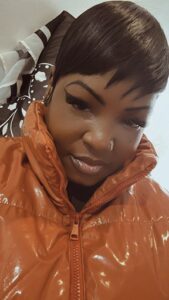
Shanice Figeroux is a NYC-born visual and performing artist dedicated to fostering mental wellness and community connection through art. Rooted in Jamaica, Queens, her practice spans diverse collaborations with nonprofits, research institutions, City Councils, corporations, businesses, schools, and faith-based organizations, all focused on creating impactful programming for women, children, and communities of color.
Building on a strong foundation established through participation in the NYC Department of Cultural Affairs’ Public Artist in Residence programs, Shanice has partnered with esteemed organizations such as ArtBridge, City Artist Corps, Jamaica BID, A Little Piece of Light, STREETLAB, VFW Post Veterans Events, Pomonok Community Center, Cohen’s Children’s Hospital, Montefiore Children’s Hospital, Queens Rising, NYC Department Of Transportation, Essential Kitchen, Jamaica Center for Arts & Learning, The Blaque Resource Network, and the World Health Organization and multiple community centers schools an public parks. These experiences have shaped her approach to community-engaged art, emphasizing collective creative practices as a catalyst for transformation and growth.
Shanice designs innovative, low- or no-cost healing programs that integrate local businesses, nonprofits, and community organizations. Her work ignites community connections, encouraging collaborative art-making as a powerful tool for self-expression and mental wellness. A versatile artist, Shanice is skilled in clothing design, acrylic and spray paint, and the creation of unique, custom pieces. Since 2016, she has painted 14 murals, which are her specialty, for businesses across NYC’s five boroughs, single-handedly designing and executing these vibrant public artworks that reflect and celebrate local identity. As an African American female public artist from Queens, the main focal point of her career is creating art the helps shape the future of her community and others around NYC.
Shanice’s commitment to community engagement extends beyond murals. She has facilitated over 75 community events incorporating public art and creative art therapy, often culminating in the display of artwork on the very buildings of the community centers she serves. Her dedication has been recognized through prestigious awards, including a 10-month art residency with ArtBridge (immediately following her exhibition with them), a 10-month art residency with the Jamaica Arts Center (culminating in a two-month gallery exhibition), a City Artist Corps grant, and a commission from the Jamaica BID for community engagement murals. She is also a vendor with MetroPlus Health and Hospitals for mural art projects.
Looking forward, Shanice has been selected for three NYC art residencies, where she will create and exhibit work in multiple galleries. She also explores digital art through the creation of NFTs.
Work in progress:
Shanice is currently painting a pink piano for the Sing for Hope Foundation, dedicated to her grandmother who passed away recently in her arms, on May 2. The piano will be donated to Montefiore Children’s Hospital in her honor, and the piano will be displayed outside of 28 Liberty Street in Downtown Manhattan inside the Chase building, June 9th.
NB: Other than the amazing diversity, what do/did you love most about living in Queens (or Queens in general)? How has Queens changed over the years?
SF: What I love so much about Queens is you can find the best authentic food from almost any culture imaginable, from Greek, Italian, and Chinese, to West Indian, Jamaican and more. Many local restaurants are also very affordable – delicious on a budget you can’t beat that.
NB: How does Queens inspire you? What are some of your favorite places to be inspired in Queens?
SF: My inspiration growing up has often come from observing Queens in various settings & organizations from churches, schools, musical plays, community events, festivals, block parties, community giveaways, holiday celebrations and art shows. These social gatherings have been all inclusive, touching many different aspects and areas of culture that I resonate with. I find myself learning, living and loving more through affiliation with non-profit institutions, schools and community centers.
NB: What advice do you have for readers who are hoping to develop their artistic practice? How important is daily practice?
SF: Consistency is everything. This is actually the most serious piece of advice when developing your skill. It’s actually better to do a little bit of art every day than to have one non-stop work session a month. It can make a significant difference. It builds originality, confidence, control, and keeps your skills sharp, and it makes art a natural part of your daily routine.
NB: How important is personal connection and communication (networking?) in your industry?
SF: In the visual art industry personal connection and communication networking are absolutely powerful, often more so than in many other fields. While the quality of the art itself tells a story based on foundation, a thriving career in visual arts is significantly built upon relationship connecting the dots.
NB: What is the best piece of advice you’ve ever received? What is something you wish you knew a decade or two ago?
SF: My mom always said No one is better than you and your not better than anyone else. Knowing this allowed me to be confident in my moments, my investments, and my time, being labor, to be seen in a positive light would carry me far.
NB: Who are some of your favorite mural artists, performance artists, burlesque dancers, performers, poets, writers, editors, musicians, artists, filmmakers, actors, playwrights, professors, teachers, illustrators, seamstresses and other creatives with a Queens connection?
SF: Lady Pink Sandra Fabara – a legendary figure in the graffiti and street art world. I was inspired to create public art, not only make pretty pictures, but to actually use my visual voice for good, and for change for the better.
—Nicollette Barsamian
The Local-Express interview series was originated on July 3, 2013 by Nicollette Barsamian.
